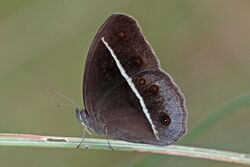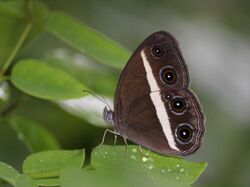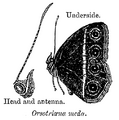Biology:Orsotriaena medus
| Orsotriaena medus | |
|---|---|

| |
| O. m. medus, dry season form, Nepal | |

| |
| O. m. mandata, Kerala, India | |
| Scientific classification | |
| Kingdom: | Animalia
|
| Phylum: | |
| Class: | |
| Order: | |
| Family: | |
| Genus: | Orsotriaena Wallengren, 1858
|
| Species: | O. medus
|
| Binomial name | |
| Orsotriaena medus (Fabricius, 1775)
| |
Orsotriaena medus is a butterfly found in south Asia, southeast Asia, and Australia .[1][2] It is the only species in the genus Orsotriaena, first described by Hans Daniel Johan Wallengren in 1858.[2]
Historical name
The butterfly has historically been called the nigger referring to its dark brown colour,[1][2][3][4] but it has been renamed in Australian faunal works to smooth-eyed bushbrown,[5] medus brown[6] in India , and dark grass-brown[7] in Southeast Asia.
Description
Orsotriaena medus is a medium-sized butterfly with wingspan of 45 to 55 mm (1.8 to 2.2 in). The butterfly is dark brown above with a thin marginal pale border. The upper hindwing having a thin submarginal line. There are no eyespots on the upperside of the wings.[8]
Below, the butterfly has a white discal band which runs across both wings. It has five eyespots on the underside of the wings. In the forewing, it has two eyespots, with the anterior eyespot slightly smaller. In the hindwing, it has two eyespots on the apical region and a separate ocellus in the tornal (hindmost) region. The uppermost of the eyespots in the hindwing are greatly smaller, while the remaining two are more or less of equal sizes.[8]
The eggs are spherical and yellowish. They are laid on the leaf blades and stems of grasses.[8] The larvae are spindle shaped, transversely wrinkled, and covered in small tubercles, giving it a rough appearance. Two long brown spines on the head point forward, while a pair of pinkish prongs project from the anal segment. The colour above is rosy red with a blue dorsal and a white lateral line, below which, the underparts are green.[9]
The pupae are perpendicularly suspended, slender and regular, except that the head-case is produced into a long beak formed of two thin processes like split straws. The colour is whitish brown to yellow, with faint bands of a darker shades. It resembles a large grain of barley or a tiny banana.[9][10]
Orsotriaena medus superficially resembles members of the genus Mycalesis (bushbrowns), but can readily be identified by the number of spots.[10]
-
Orsotriaena medus cinerea, Indonesia
-
1905 illustration of Orsotriaena medus
-
Orsotriaena medus moira, the upper surfaces of the wings of the species are unmarked and plain brown
-
Mating pair
Distribution and habitat
Orsotriaena medus is native to India , Sri Lanka, Myanmar, Cambodia, Thailand, southern Yunnan, Malaysia, the Indonesian archipelago, the Philippines , New Guinea, New Britain and Australia .[2]
In India , the butterfly occurs in South India, Punjab, Uttar Pradesh, Bihar, West Bengal, Sikkim, Assam, Nagaland, the Andaman and Nicobar Islands.[9][2]
O. medus is very common in grassy habitats up to an altitude of 1,600 m (5,200 ft). A shy, weak-flying insect, it stays low amongst the undergrowth, and when disturbed flies for a short distance before settling down. The butterfly basks in the sun, often with its body aligned parallel to the sun's rays.[8]
Taxonomy
Orsotriaena medus is classified under the subfamily Satyrinae (the browns) of the brush-footed butterfly family Nymphalidae.[2][11] Orsotriaena medus is divided into several subspecies, listed below with their respective synonyms and geographical ranges.[2]
- Orsotriaena Wallengren, 1858
- syn. Orstriaena Young, 1903; Orsotrioena Bingham, 1905
- Orsotriaena medus (Fabricius, 1775)
- syn. Papilio medus Fabricius, 1775; Mycalesis mandosa Butler, 1868
- Orsotriaena medus cinerea (Butler, 1867) – Sundaland
- syn. Mycalesis cinerea Butler, 1867
- Orsotriaena medus jopas (Hewitson, 1864) – North Sulawesi
- syn. Mycalesis jopas Hewitson, 1864
- Orsotriaena medus mandata (Moore, 1857) – Sri Lanka, South India[1]
- syn. Mycalesis mandata Moore, 1857[12]
- Orsotriaena medus medus (Fabricius, 1775) – N. India to Thailand, Timor, the Philippines , Papua New Guinea, South Yunnan
- syn. Papilio hesione Cramer, 1775; Papilio doris Stoll, 1781; Mycalesis runeka Moore, 1857
- Orsotriaena medus mendice (Fruhstorfer, 1911) – South Sulawesi
- syn. Orsotriaena mendice Fruhstorfer 1911
- Orsotriaena medus moira (Waterhouse & Lyell, 1914) – Banks Island, Darnley Island, Cape York
- syn. Orsotriaena moira Waterhouse & Lyell, 1914
- Orsotriaena medus mutata (Butler, 1875) – New Britain
- syn. Orsotriaena mutata Butler, 1875
- Orsotriaena medus paupercula (Fruhstorfer, 1908) – Sula Islands
- syn. Orsotriaena paupercula Fruhstorfer, 1908
- Orsotriaena medus zipoetina (Fruhstorfer, 1908) – Sumatra
- syn. Orsotriaena zipoetina Fruhstorfer, 1908
- syn. Papilio medus Fabricius, 1775; Mycalesis mandosa Butler, 1868
Ecology and behaviour
The larvae feed on grasses, including rice plants (Oryza sativa), sugarcanes (Saccharum officinarum),[9][2] and para grass (Brachiaria mutica).[13] They are predominantly crepuscular, but can sometimes be active during daytime.[10]
See also
References
- ↑ 1.0 1.1 1.2 R.K., Varshney; Smetacek, Peter (2015). A Synoptic Catalogue of the Butterflies of India. New Delhi: Butterfly Research Centre, Bhimtal & Indinov Publishing, New Delhi. pp. 175–176. doi:10.13140/RG.2.1.3966.2164. ISBN 978-81-929826-4-9. https://www.researchgate.net/publication/287980260.
- ↑ 2.0 2.1 2.2 2.3 2.4 2.5 2.6 2.7 Savela, Markku. "Orsotriaena medus (Fabricius, 1775)". http://www.nic.funet.fi/pub/sci/bio/life/insecta/lepidoptera/ditrysia/papilionoidea/nymphalidae/satyrinae/orsotriaena/#medus.
- ↑ Evans, W.H. (1932). The Identification of Indian Butterflies (2nd ed.). Mumbai, India: Bombay Natural History Society. pp. 123–124, ser no D16.1.
- ↑ Kunte, Krushnamegh (2000). Butterflies of Peninsular India. India, A Lifescape. Hyderabad, India: Universities Press. p. 115. ISBN 978-8173713545. https://books.google.com/books?id=cuPPjOMcu_4C.
- ↑ Australian Faunal Directory, Government of Australia (Dept of Environment & Water Resources) page on Orsotriaena medus. Accessed 28 April 2018
- ↑ "Orsotriaena medus Fabricius, 1775 – Medus Brown". http://www.ifoundbutterflies.org/#!/sp/564/Orsotriaena-medus.
- ↑ Kirton, Laurence G. (2014). A Naturalist's Guide to the Butterflies of Peninsular Malayasia, Singapore and Thailand. Oxford:John Beaufoy Publ. p.62.
- ↑ 8.0 8.1 8.2 8.3 Haribal, Meena (1992). The Butterflies of Sikkim Himalaya and Their Natural History. Gangtok, Sikkim, India: Sikkim Nature Conservation Foundation. pp. 144–145, ser 352.
- ↑ 9.0 9.1 9.2 9.3
 This article incorporates text from a publication now in the public domain: Bingham, Charles Thomas (1905). Fauna of British India. Butterflies Vol. 1. pp. 69–70. https://archive.org/stream/butterfliesvolii00bing#page/68/mode/2up/.
This article incorporates text from a publication now in the public domain: Bingham, Charles Thomas (1905). Fauna of British India. Butterflies Vol. 1. pp. 69–70. https://archive.org/stream/butterfliesvolii00bing#page/68/mode/2up/.
- ↑ 10.0 10.1 10.2 Adrian Hoskins. "Butterflies of Thailand, Malaysia & Borneo: Nigger, Orsotriaena medus FABRICIUS, 1775". Learn about Butterflies: the complete guide to the world of butterflies and moths. http://www.learnaboutbutterflies.com/Malaysia%20-%20Orsotriaena%20medus.htm.
- ↑ Beccaloni, G.; Scoble, M.; Kitching, I. et al., eds (2003). "Orsotriaena medus". The Global Lepidoptera Names Index. Natural History Museum. https://www.nhm.ac.uk/our-science/data/lepindex/detail/?taxonno=143494.
- ↑ Cite error: Invalid
<ref>tag; no text was provided for refs namedMooreIndica - ↑ Kalesh, S & S K Prakash (2007). "Additions of the larval host plants of butterflies of the Western Ghats, Kerala, Southern India (Rhopalocera, Lepidoptera): Part 1". Journal of the Bombay Natural History Society 104 (2): 235–238.
External links
Wikidata ☰ Q2715907 entry
 |





